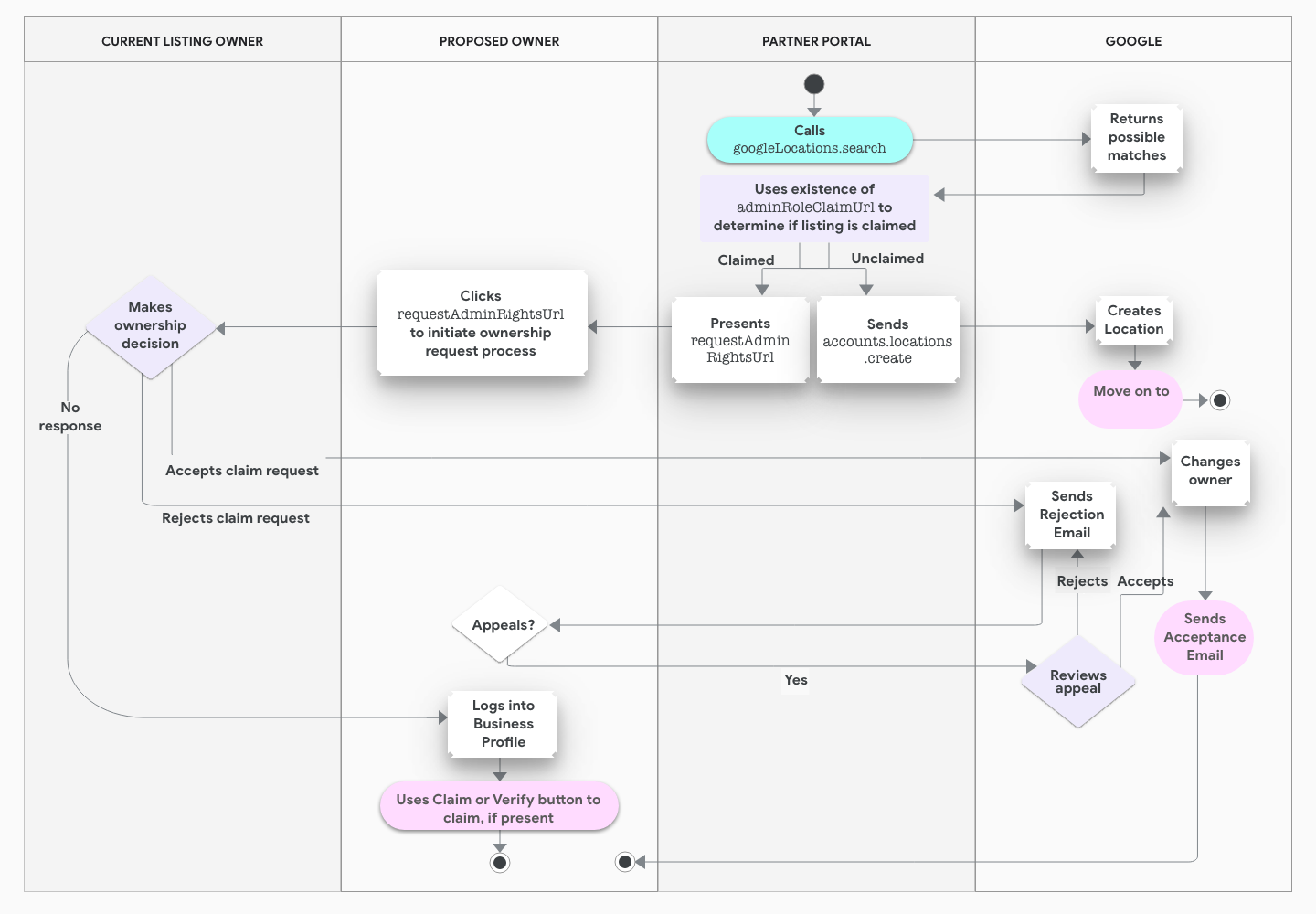تتيح لك GoogleLocations API معرفة ما إذا تم المطالبة بموقع جغرافي في "الملف التجاري على Google" مسبقًا. بهذه الطريقة، إذا تمّت المطالبة بالموقع الجغرافي، يمكنك طلب الوصول إليه على الفور. بالإضافة إلى ذلك، إذا كنت تدير حسابات تم إثبات ملكيتها بشكلٍ مجمّع، يمكنك تحديد المطابقات المحتملة مسبقًا بدقة أكبر وتجنُّب إنشاء مواقع جغرافية مكرّرة.
تعرض نقطة نهاية واجهة برمجة التطبيقات عنوان URL يشير إلى ما إذا سبق أن تمّت المطالبة بموقع جغرافي. إذا كان قد تمّت المطالبة به، يتيح لك عنوان URL نفسه بدء عملية طلب الوصول.
تقدّم الصورة التالية نظرة عامة على عملية اكتساب ملكية موقع جغرافي.

تتيح لك الخطوات التالية استخدام واجهة برمجة التطبيقات GoogleLocations:
- جمع بيانات الموقع الجغرافي من التاجر
-
اتصل بنقطة نهاية
googleLocations.search. قدِّم بيانات الموقع الجغرافي في نص المكالمة. بدلاً من ذلك، يمكنك تقديمه في سلسلة طلب بحث، مثل ما قد يُدخله المستخدم في "بحث Google" أو "خرائط Google". على سبيل المثال، "Starbucks 5th ave NYC".تعرض واجهة برمجة التطبيقات قائمة بالمواقع الجغرافية التي يُحتمل أن تتطابق مع طلبك ومعلومات عن كل موقع جغرافي، مثل
locationNameوالعنوان. - اختَر الموقع الجغرافي الذي يطابق موقعك الجغرافي. إذا لم يتم العثور على أي مطابقات، اتصل بالرقم
accounts.locations.createوانتقِل إلى الخطوة 5. -
استنادًا إلى حالة
requestAdminRightsUrlفي الردّ، اتّخِذ الإجراءات التالية:- إذا كان
requestAdminRightsUrlمتوفّرًا، يعني ذلك أنّ مستخدمًا آخر يملك بيانات المنتج. وجِّه التاجر إلى عنوان URL لبدء طلب الوصول إلى الموقع الجغرافي الحالي وملكيته في "الملف التجاري". - إذا لم يكن
requestAdminRightsUrlمتوفّرًا، يُرجى الاتصال بـaccounts.locations.createوإنشاء بيانات جديدة سيتم إثبات ملكيتها لاحقًا.
- إذا كان
- إذا أنشأت بيانات جديدة كجزء من هذه العملية، يمكنك استخدام واجهات برمجة التطبيقات الخاصة بإثبات الملكية لبدء عملية إثبات ملكية البيانات. لمزيد من المعلومات، يُرجى الاطّلاع على إدارة عملية إثبات الملكية.
